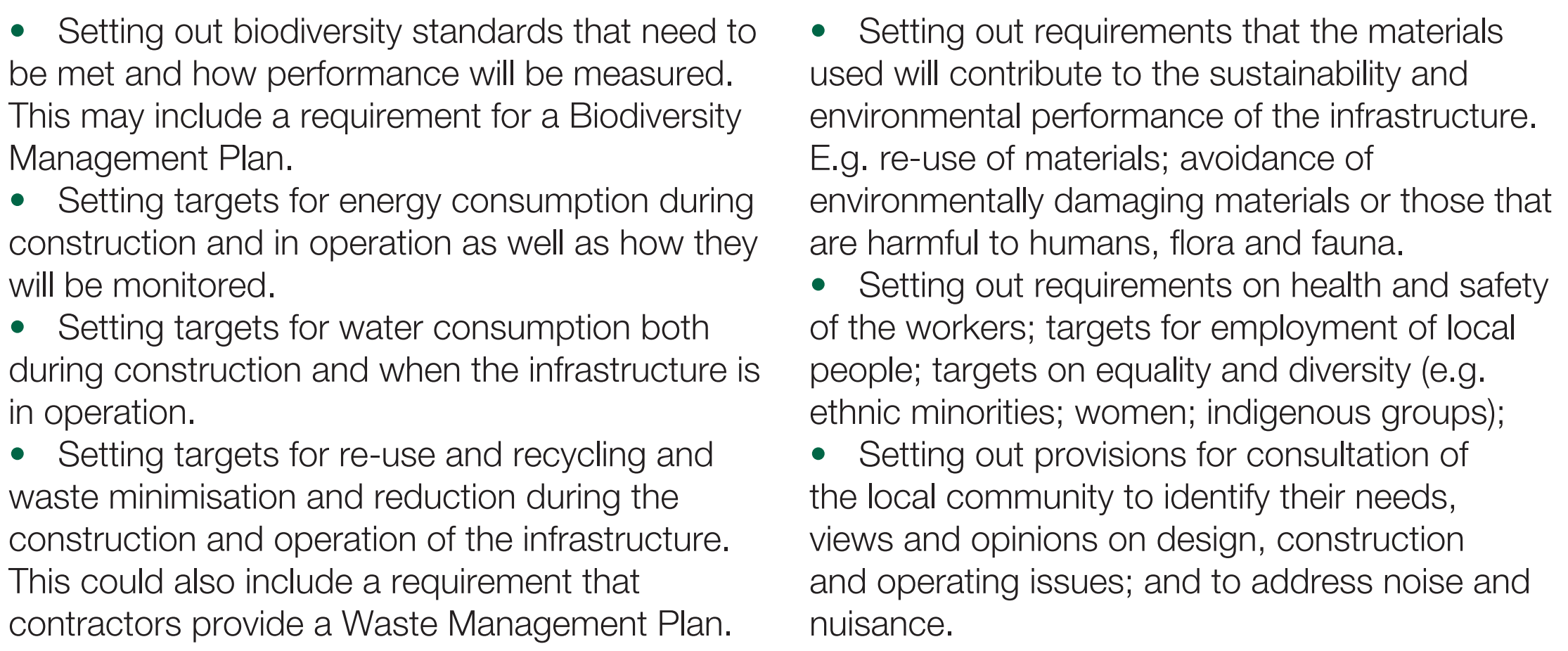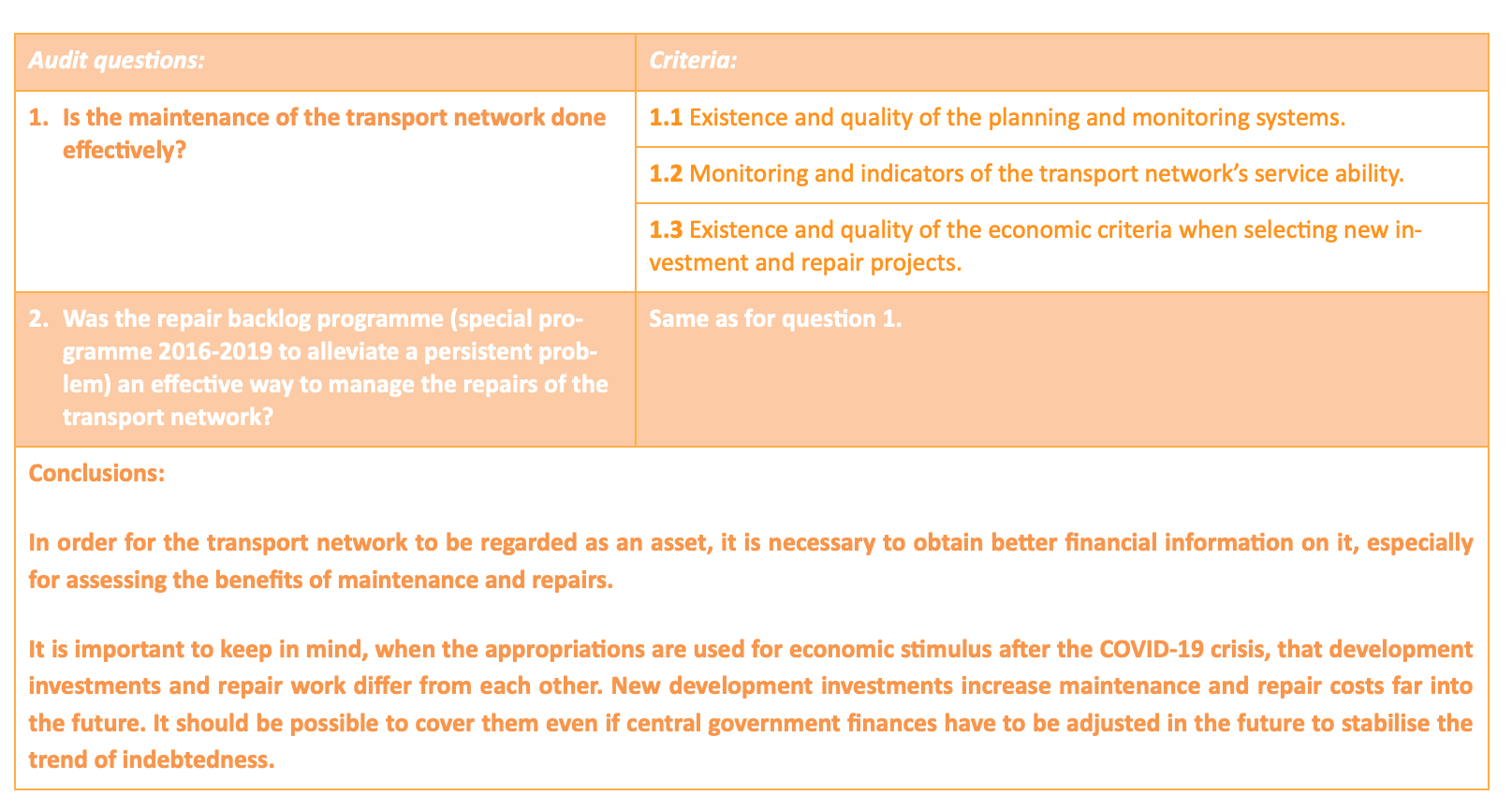MOOC: Auditing environmental impacts of infrastructure
2.3. Project Delivery

During this stage, the technical solutions are put in place, contracts are signed and procurement procedures are carried out. In most countries, there are procurement laws that need to be followed.
Design specification
In this phase, the contractor and supervisor have the opportunity to manage the environmental and sustainability performance of an infrastructure project. During the design phase, it is necessary to identify construction materials and methods for achieving sustainability targets, to identify the Best Available Technique applicable to the infrastructure and to specify any other features that would sustainably help improve the operational performance of the infrastructure in question.
The concept of the Best Available Technique or BAT refers to the standards and technologies approved by legislation to meet the desired outcomes. According to EU Directive 2010/75/EU, BAT is the most effective and advanced stage in the development of activities and their methods of operation, which indicates the practical suitability of particular techniques. Though that definition sounds complicated, the concept itself is quite simple: if the developer is building an electricity production plant and the goal of the legislator is to minimise emissions, the legislator will require the developer to use the best technology in existance for reducing emissions. In reality, though, the cost aspect is also taken into consideration, which means that the legislator will require the developer to use the best reasonably priced technology available. BAT can also be a good source of audit criteria. For example, governments usually set a BAT for emission and effluent limits.
 |
Reading suggestion!To find out more about BAT and best practices in the field, take a look at the OECD study on ‘Policies on Best Available Techniques or Similar Concepts Around the World‘. The OECD study is a valuable source for both getting to know the area when planning an audit and finding potential audit criteria. |
The design of the infrastructure can incorporate features that will encourage future users to reduce the negative environmental impact of their behaviour and act in a more environmentally friendly manner.
Considerations for the design process may include:

Extract from the INTOSAI WGEA material ‘Environmental Issues Associated with Infrastructure Development’ (INTOSAI WGEA, 2013)
Contract management
The contract should describe the rights and responsibilities of the infrastructure developer and establish mechanisms for monitoring and liability.
Auditors can, for example, analyse whether there are adequate provisions in place for environmental protection and sustainability in the contracts. FIDIC contracts are widely used nowadays in infrastructure construction. Though they might be a good source of criteria, it is worth noting that FIDIC contacts are not free for public use and up to the auditors to decide whether it is appropriate to use them as a source of criteria.
Contract conditions should also ensure that suppliers report adequately on their performance in terms of environmental/sustainability requirements. Suppliers can be also encouraged to respect environmental and sustainability objectives on a voluntary basis throughout their supply chain.
Special consideration is needed for projects developed as public-private partnerships (PPP). The contracts governing these projects are generally quite complex and cover a long time span. According to the World Bank, PPP projects are a mechanism for governments to procure and implement public infrastructure and/or services using the resources and expertise of the private sector. PPP projects are typically projects where the private party is in charge for most if not all of the infrastructure development stages brought out in this module, but the public entity must ensure the agreed-upon monetary compensation for the work done by the private entity. This means that the public entity will either directly pay the private entity or the private entity will collect a fee from the users of the infrastructure. In the first case, for example, the government pays its private partner every time the partner provides the agreed-upon volume of services in the hospital. In the second case, for example, users pay a toll for using the new highway. Even in the latter case, usually the public entity must reimburse the private entity if the collected fee does not cover the investments made by the private entity. PPP is also the cornerstone for SDG 17 – Partnership for the Goals. Target 17.17 of goal 17 entitled ‘Encourage effective partnership’ aims to encourage and promote effective public, public-private and civil society partnerships.
 | Reading suggestion!INTOSAI is in the process of renewing the PPP auditing guide – take a look at the project process here. Once the guide is ready, it will give auditors ideas and framework for auditing PPP projects, contracts, frameworks, etc. Also take a look at the PPP Knowledge Lab for information on what constitutes a PPP project, what to look for in the framework of PPP contracts and much more. |
Audit example:
Brazil’s Federal Court of Accounts (TCU) received 17 studies on PPP projects in the infrastructure sector from the federal government in the period from October 2019 to September 2020. In all of the projects analysed, possible procedural improvements were identified and managers were informed.
Due to the number of public resources involved and the relevance of the projects, TCU opened a specific case file for each of the projects and carried out technical analysis regarding all studies, pointing out eventual risks and issuing recommendations and stipulations to the project managers to mitigate them or eliminate the causes. Presented below are the main audit findings.

 | Audit suggestion!Take a look at this PPP audit by the European Court of Auditors which concludes that the audited projects were not always effectively managed and did not provide adequate value for money. Potential benefits of PPPs were often not achieved, as they suffered delays, cost increases and were under-used, and resulted in 1.5 billion euro ineffective spending, out of which 0.4 billion euro EU funds. |
Another type of contracts to look out for are Production Sharing Agreements or PSAs. These are typically contracts between the government and private entity whereby the government contracts with the investor to carry out , typically, oil or gas exploration and production activities in a defined area for a defined period of time. Auditors might want to check whether these contacts involve sustainability clauses or whether there are unfair taxes or royalties involved that point to corruption.
Procurement standards
Sustainable (green) procurement is a key way of incorporating environmental and sustainability considerations into the design, procurement and construction processes. The European Commission has defined Green Public Procurement (GPP) as “a process whereby public authorities seek to procure goods, services and works with a reduced environmental impact throughout their lifecycle when compared with goods, services and works with the same primary function that would otherwise be procured”.
Decisions taken at this stage can minimise any adverse impacts identified in earlier assessments as well as seek to enhance potentially positive impacts. In infrastructure projects, procurement principles can apply to the project as a whole or to the purchase of goods or services within the project. Governments can use the procurement process to drive the efficiency of suppliers and their supply chains, influence the delivery of the infrastructure and guarantee that, prior to the construction and operation of the infrastructure, both environmental and sustainability considerations are taken into account.
Governments may decide to establish official standards which form mandatory specifications in order to guarantee that sustainable outcomes are achieved.
There are many examples of international and national best practice standards, such as the EU Greening Public Procurement Criteria, for sustainable forestry products (the Forest Stewardship Council certification) and for building standards (in the UK, BREEAM assessments of the sustainability of building specifications) and health and safety standards for working environments.
 | Reading suggestion!Take a look at the aspects and questions auditors might want to look at when auditing public procurements from the 2011 AFROSAI-E guide, the 2016 ASENSAI guide or the 2011 guide by the Contact Committee of the Supreme Audit Institutions of the European Union. The INTOSAI is in the process of renewing the Public Procurement Audit guide – see the project process here. |
Lifecycle costing
Lifecycle costing (LCC) is a method that provides information about all the costs of products and services throughout their lifecycle. Lifecycle Assessment (LCA) and Whole-Life Costing provide tools to quantify and assess the consequences of products or services during every stage of an infrastructure project.
While these tools sound similar, there are some key differences between LCA and LCC. LCA is generally used to determine the (environmental) impact of a project, product or service. For example, the environmental impact of a wind power plant is not merely the reduction of carbon dioxide due to less use of fossil fuels; the construction materials and processes used in its production as well as the impact of decommissioning have to be taken into consideration. Lifecycle costing, on the other hand, deals with the monetary cost of a project throughout the project lifecycle. This means, for example, that the cost of a new bridge is not merely the cost of building it but also the cost of maintenance, repairs, etc.
Audit example:
‘Lifecycle management of the transport network’ (National Audit Office of Finland, 2020)
The National Audit Office of Finland has audited lifecycle costs on various occasions. Their latest audit, published in 2020, focuses on the transport network. They found that repair operations and investments are closely connected. The connection between development investments, maintenance and repairs is particularly evident in the planning and implementation of the total funding for the transport network. The construction and maintenance of the transport network requires a very long-term perspective. Steady and foreseeable funding would support the lifecycle management of the network and also bring financial benefits. The table below illustrates the questions and criteria applied in this audit as well as the main conclusions drawn.

 | Reading suggestion!To find out more about how to audit a project’s lifecycle costs, including the standards used for asset management, take a look at these guidelines for auditing project lifecycle costs by the National Audit Office of Finland |
 | Audit suggestion!In this stage, the construction of infrastructure takes place. Auditors may want to look at, for example, whether all the standards, design specifications and laws are being followed or whether the construction is within budget and on time. One option is to audit the quality of the construction works, as was done by the National Audit Office of Tanzania. To see the criteria and methods used, take a look at their audit on the quality of executed bitumen-surfaced road works in urban areas. One of the audit findings was that the main reasons for the existing poor bitumen-surfaced roads were the use of inadequate road designs and poor supervision during the construction of the respective roads. |

